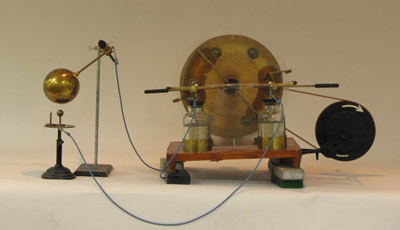Lightning Rod 5B30.30
The Lightning Rod apparatus is in the Electrostatics Cabinet, B2.
The Toepler-Holtz machine is in the Electrostatics Cabinet, A3.
Use the insulated handles to bring together the electrodes of the Toepler-Holtz machine, thus discharging it, before attaching any leads to it.
Note: The spark from the big Toepler-Holtz Machine carries higher current than the Department's Wimshurst machine or Van de Graaff Generator, possibly a large enough current to cause injury. Discharge the machine before touching the metal parts, or allowing students near it.
Attach one electrode of the Toepler-Holtz machine to the large brass ball of the Lightning apparatus, and attach the other electrode to the plate.
Place the small brass ball on the plate, and remove the small brass spike. Set the height of the plate so the minimum distance between the large and small brass balls is about 2.5 cm.
Set the electrodes of the Toepler-Holtz machine 5 cm or more from each other.
Turn the crank of the Toepler-Holtz machine. Periodically, large sparks should jump between the large and small brass balls.
Bring the electrodes of the Toepler-Holtz machine together to discharge it.
Remove the small brass ball, and place the small brass spike on the plate.
Turn the crank. Now there should be no sparks.
Discharge the Toepler-Holtz machine.
Place the small brass ball on the plate next to the small brass spike.
Turn the crank. There should still be no sparks. The brass spike "protects" the small brass ball.
Discussion: The sharp tip of the brass spike becomes surrounded by a large electric field as charge builds up. The electric field becomes large enough to ionize the air around the tip. The ions and electrons then go in opposite directions, to the negative and positive electrodes respectively, thus forming a current which acts to discharge the Toepler-Holtz. This type of phenomenon is called a "corona discharge". The corona discharge may be seen as a purple or blue-white glow surrounding the sharp tip. Outside the physics lab, corona discharges on ships at sea during electrical storms are called "St. Elmo's Fire".
While the name of this demonstration is "Lightning Rod", it is a matter of dispute whether the production of a corona by a sharp conductor placed on top of a building helps prevent the building from being struck by lightning. It is universally agreed that a conductor that is well-connected to ground, by a path that lies exterior to the building on which it is placed, protects the building from damage when lightning strikes.
